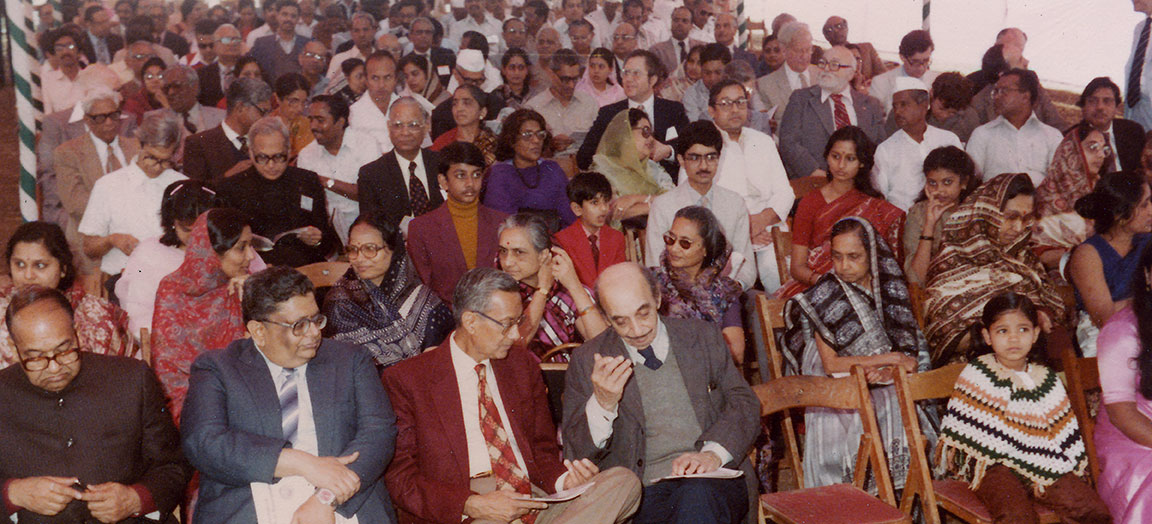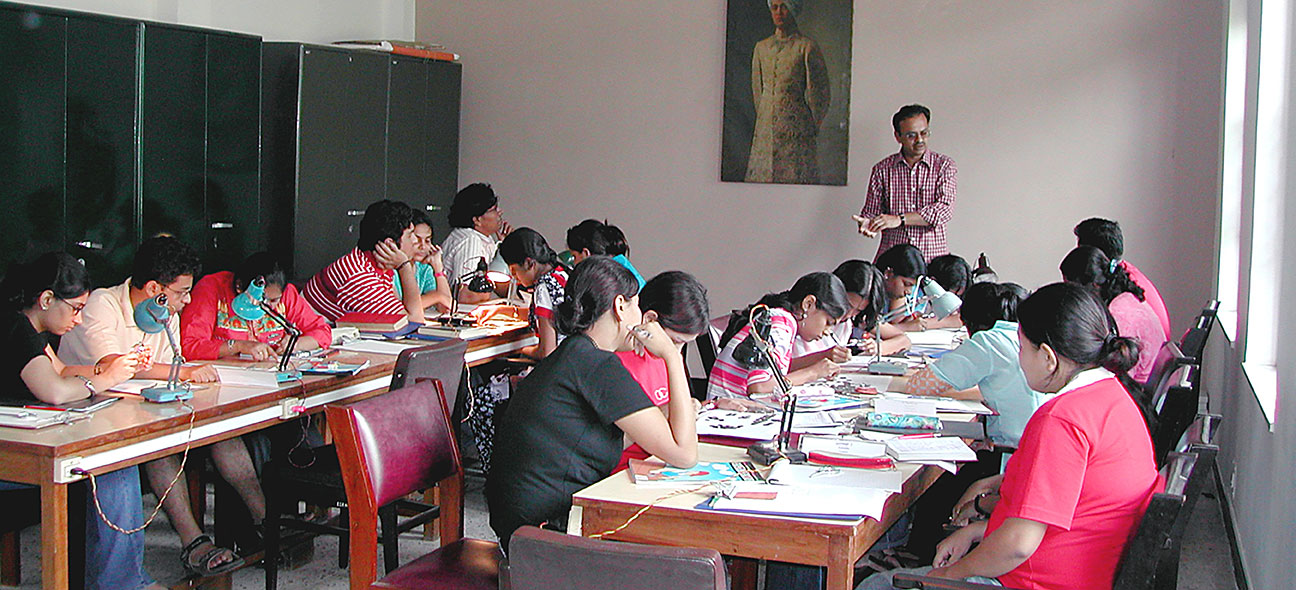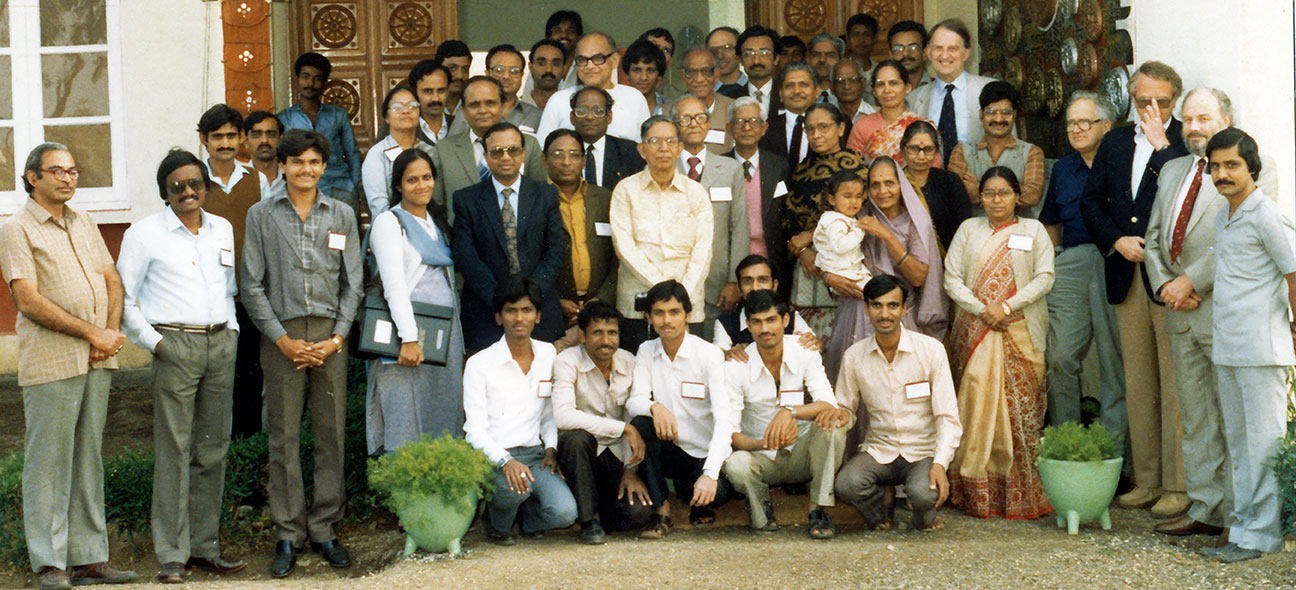Milestones
1980
- Indian Institute of Research in Numismatic Studies (IIRNS) registered as an NGO.
1980 – 1983
- Selection of suitable and buying of land for the Research Centre.
- Planning and construction of the building.
- Collection of Research Data and the beginning of Photo Archives and Negative Archives sections with documentation of about 25000 coins.
- Receiving Dr. Parmeshwari Lal Gupta’s library and developing the institute’s library around this nucleus.
- The numismatic Society of Bombay merges with IIRNS.
1984
- Inauguration of IIRNS at Anjaneri, Nashik by the renowned art historian Karl Khandalawala.
- 1st International Colloquium on ‘Numismatics and History’.
1987
- Inauguration of the Institute’s first museum with displays under the theme ‘Indian Coinage: A Panoramic View’.
- 2nd International Colloquium on ‘Numismatic and Archaeology’.
- First Practical Numismatic training course conducted laying the foundation for future courses.
1988
- J.N. Ahivasi’s collection of bronzes, miniature paintings, books, manuscripts etc received in gift from his daughter Dr. Devaki Ahivasi.
- Dr. Amjad Ali, Warangal gifted part of his coin collection.
1989
- Building of a residential facility for the visiting scholars and students.
1991
- 3rd International Colloquium on ‘Coinage, Trade and Economy’.
- Collaborative Project with Society for South Asian Studies, U.K. on Foreign Coins Part I Western- (Roman to Venetian) found in Southern and Western India initiated.
1992
- Collaboration with IsMeo, Rome, Italy for an exhibition in India on the theme ‘Roman Contacts with India’.
1993
- The Library of Late Dr. P.M. Joshi received as a gift.
1994
- Generous gift of coins, sculptures, bronzes, porcelains, books etc from Dr. Amjad Ali, Warangal.
1995
- 4th International Colloquium on ‘Foreign Coins Found in the Indian Subcontinent’.
1999
- Displays of the museum shifted to a newly constructed building with the inauguration of ‘KG Maheshwari Photo Art Gallery’.
2001
- 5th International Colloquium on ‘Medieval Indian Coinages: A Historical and Economic Perspective’.
2002
- Munifient gift of Late (Prof.) Ajay Mitra Shastri’s library of nearly 2800 books, journals, periodicals and also papers of the late Prof. Shastri received from his son, Shri Avinash Upadhyaya, Nagpur.
2003
- A part of the Library of Dr. Shobhana Gokhale received as a gift.
2004
- Modernized Money Gallery of the Museum inaugurated.
2005
- Commencement of the scientific documentation of rock art sites of Rajasthan.
2007
- The name ‘Indian Institute of Research in Numismatic Studies’ (IIRNS) changed to ‘Indian Numismatic, Historical and Cultural Research Foundation’ (henceforth INHCRF) to reflect expanding activities.
2008
- Part library of Late (Dr.) Malti Mahajan, Nagpur and a collection of thesis and books from Dr. R.K. Sharma, Jabalpur received as gift.
2009
- Under the National Mission on Monuments and Antiquities (NMMA), Archaeological Survey of India assigned the work of preparing classified digital documentation of the numismatic collection of Sheesh Mahal Museum, Patiala to INHCRF.
- First workshop on ‘Prehistoric Archaeology’ by INHCRF conducted.
- Documentation of the megalithic sites of Mohurjhari and Junapani in Vidarbha started after signing an MoU with Prof Mayank Vahia of Tata Institute of Fundamental Research (TIFR), Mumbai.
2010-2011
- NMMA assigned the documentation of the numismatic collections of Central Antiquity Collection, Purana Quila, A.S.I, Red Fort Museum, and S.P.S. Museum, Srinagar to the INHCRF. 152000+ coins were documented in the next three years.
2012
- Joint archaeological exploration programme with Dr. Michael Willis of British Museum, London was undertaken in the Ellichpur area of Amravati district, Maharashtra under the project ‘Sacred Landscapes of Ramtek, Nagpur.
2013
- Along with Dr. Nayana Tadvalkar, INHCRF team documented audio-visuals of mask making and Bohada Festival in the tribal areas of Jawhar, Maharashtra.
2014
- Signing of MoU between the British Museum, London and INHCRF for a collaborative project ‘The Archaeology of Hindu Kingdom in Ancient Vidharbha’ which was a part of the larger project under the European Research Council’s ‘Beyond the Boundaries: Religion, Region, Language and the State’ that spanned for four years.
- Documentation of numismatic collections of Patna Museum, Bihar and Hinduja Foundation, Mumbai undertaken.
2015
- Sanction of a grant for the development of ‘Shanti-Krishna Museum of Money & History’ under the Museum Grant Scheme by the Ministry of Culture, Government of India.
- Signing of an MoU with the Deccan College Post-Graduate Research Institute (DCPRI), Deemed University, Pune for strengthening, formalizing and cementing the already existing relations between two Institutions for the promotion of studies and research in the fields of archaeology, numismatics and allied subjects.
2016
- Commencement of the work of re-development of the ‘Shanti-Krishna Museum of Money & History’.
2018
- Undertook joint verification of the numismatic collection of the Chhatrapati Shivaji Maharaj Vastu Sangrahalaya, Mumbai.
- Refurbished ‘Shanti-Krishna Museum of Money & History’ opened to the public.
- Signed general cooperation MoU with the University of Warsaw, Faculty of History, Warsaw, Poland.
- Signed research cooperation MoU with the ELTE Eotvos Lorand University, Faculty of Humanities, Budapest, Hungary.
2019
- Signing of an MoU with the Hinduja Foundation, Mumbai for conducting an outreach programme comprising 15 Introductory workshops on Know Your Coins, Learn Your History, Prehistoric Man in India, etc, and three residential workshops on numismatics and archaeology.
- Signing of MoU between the Institute of Archaeology, University of Warsaw, Poland and INHCRF for undertaking a collaborative project ‘The Nala Sopara Surface Survey’.
2020
- Under the MoU with the Institute of Archaeology, University of Warsaw, the ancient port site of Nalasopara was jointly explored and documented by the Polish and INHCRF archaeologists.
2021
- The 5th Prehistory Training Workshop "Stones, Skills and Sediments: Tracking the Imprints of Prehistoric Past" was held from 2nd to 8th December 2021.
- The 13th Practical Workshop on identification and decipherment of Medieval Indian Coins was organised between 25th and 29th DEcember 2021.
2022
- First practical course on "Introduction to Epigraphical and Palaeographical studies" commenced from 4th to 10th July 2022 at INHCRF campus in Nashik. The resource person for the workshop was Dr T. S. Ravishankar, former director (Epigraphy), ASI, Mysore.
- First practical course on "Introduction to Epigraphical and Palaeographical studies" commenced from 4th to 10th July 2022 at INHCRF campus in Nashik. The resource person for the workshop was Dr T. S. Ravishankar, former director (Epigraphy), ASI, Mysore.
- The Rotary Club of Nasik Godavari in association with Indian Numismatic, Historical and Cultural Research Foundation (INHCRF), Nashik celebrated Friendship Day with The Nature by planting 200 native trees of 16 different varieties having great medicinal value.
- First residential short term certificate course on Perso-Arabic inscriptions and calligraphy entitled "Decoding Epigraphs of Medieval India: An Introductory workshop on Perso-Arabic Inscriptions and calligraphy" was held from 12th to 18th October 2022. The resource person, Dr G.S. khwaja, Former Director Epigraphy (Arabic and Persian Inscriptions), Archaeological Survey of India, Govt. of India
- INHCRF congratulates Dr. Riza Abbas, Director -INHCRF for availing Homibaba Research Fellowship for 2022-24 academic year.
- The 6th prehistory workshop entitled "Stones, Skills and Sediments: Tracking the Imprints of Prehistoric Past" was held at INHCRF, Nashik from 1st to 7th November 2022 exclusively for St. Xavier's College, Mumbai.
- The 7th prehistory workshop entitled "Stones, Skills and Sediments: Tracking the Imprints of Prehistoric Past" was organised at INHCRF, Nashik from 11th to 17th November 2022.
- The glimpses of a specialised eight days practical training workshop on Prehistory, Numismatics, Museology, Art and Architecture was organised from 9th to 16th December 2022 for the undergraduate students of Marthoma College for women Perumbavor, Ernakulam, Kerala.
- Dr. Riza Abbas, Director INHCRF was invited by the Department of Archaeology and Museums, Government of Goa to conduct a survey of Rock Art of Pansymol and surrounding areas between 22nd and 24th December 2022.
2023
- One day international symposium on Buddhist Culture and Heritage organised by SAVITRIBAI PHULE PUNE UNIVERSITY DEPARTMENT OF PALI AND BUDDHIST STUDIES in collaboration with INHCRF, Nashik was successfully accomplished on 23rd March 2023.
- Prof Arkadiusz Dymowski and Dr Krylo Myzgin of University of Warsaw, Poland visited INHCRF, Nashik for library referencing for their research on finds of Indo-Roman Coins and their imitations in India and ethnography related to imitations of Venetian Ducates, Locally known as Putali's.
- The 2nd practical training workshop on "Digital Archaeology" was held between 16th and 22nd January 2023. The resource person for the workshop was Shri Hemant Dalavi, Senior Research Associate, Mythic Society, Bengaluru.
- One day introductory course on Ancient Indian coins by Amiteshwar Jha was conducted for KJ Somaiya centre for Buddhist studies on 9th February 2023.
- The 14th residential short term certificate course on "Identification and Decipherment of Medieval Indian Coins" in collaboration with Maulana Azad National Urdu University, Hyderabad was held from 14th to 17th February 2023. The resource person for the workshop was Dr Danish Moin, Professor and Head, Department of History, MANUU, Hyderabad.
- On 15th February 2023, Memorandum of Understanding (MOU) is signed between INHCRF and Department of Pali and Buddhist Studies, Savitribai Phule Pune University, Pune by Dr. K. K Maheshwari (Chairman, INHCRF) and Prof. Mahesh Deokar (HOD, Department of Pali and Buddhist Studies) in the presence of Smt. Madhurika K Maheshwari (Trustee, INHCRF), Prof. Shrikant Bahulkar, Prof. Shraddha Khumbhojkar, Dr Shrikant Ganvir, Dr Riza Abbas and other dignitaries. The objectives of the MOU are to establish, extend and encourage academic ties as well as academic cooperation and exchange.




